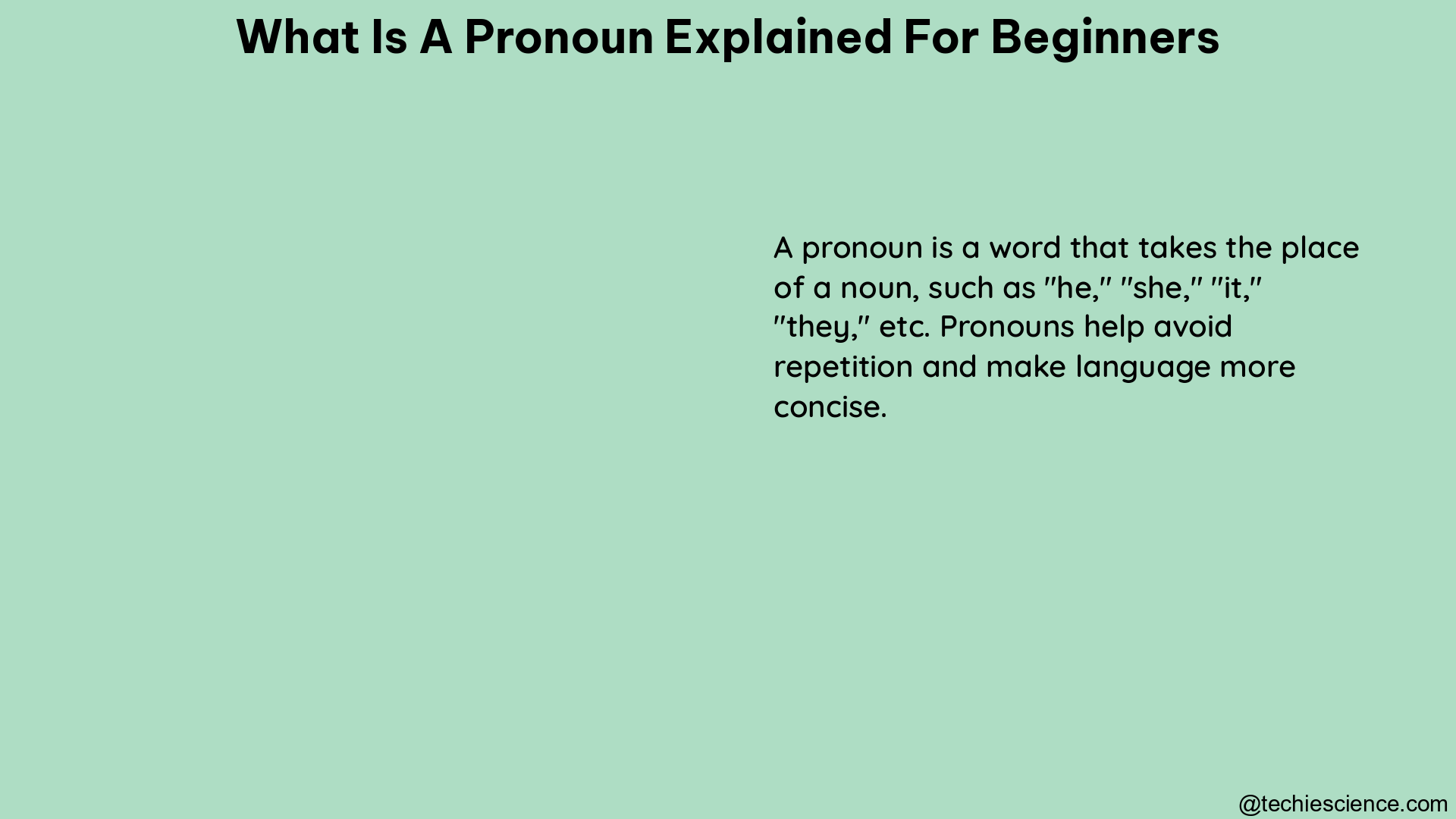A pronoun is a word that replaces a noun in a sentence to avoid repetition and make communication more efficient. Pronouns are used to refer to a person, place, thing, or idea without repeating the noun. They help in constructing sentences that are easier to understand and provide context and clarity to the message.
Types of Pronouns
Pronouns can be classified into several categories based on their function and usage. Let’s explore the different types of pronouns in detail:
1. Personal Pronouns
Personal pronouns are used to replace nouns that refer to people or things. They can be subjective (e.g., “I,” “you,” “he,” “she,” “it,” “we,” “they”), objective (e.g., “me,” “you,” “him,” “her,” “it,” “us,” “them”), or possessive (e.g., “my,” “your,” “his,” “her,” “its,” “our,” “their”).
Example:
– Subjective: “She is going to the park.”
– Objective: “I gave the book to him.”
– Possessive: “That is their car.”
2. Demonstrative Pronouns
Demonstrative pronouns are used to point out specific nouns. They include “this,” “that,” “these,” and “those.”
Example:
– “This is my favorite shirt.”
– “Those are the books I need.”
3. Interrogative Pronouns
Interrogative pronouns are used to ask questions. They include “who,” “what,” “which,” and “whom.”
Example:
– “Who is coming to the party?”
– “What did you buy at the store?”
4. Indefinite Pronouns
Indefinite pronouns do not refer to specific nouns. They include “all,” “another,” “any,” “everybody,” “nobody,” “someone,” and “everything.”
Example:
– “Everybody is invited to the picnic.”
– “Someone left their wallet on the table.”
5. Reflexive Pronouns
Reflexive pronouns are used to refer back to the subject of a sentence. They include “myself,” “yourself,” “himself,” “herself,” “itself,” “ourselves,” “yourselves,” and “themselves.”
Example:
– “I cut myself while cooking.”
– “She bought herself a new dress.”
6. Possessive Pronouns
Possessive pronouns show ownership or possession. They include “mine,” “yours,” “his,” “hers,” “its,” “ours,” and “theirs.”
Example:
– “This is my book, not yours.”
– “The car is hers, not theirs.”
7. Relative Pronouns
Relative pronouns are used to connect clauses. They include “who,” “whom,” “that,” and “which.”
Example:
– “The person who called me earlier is my friend.”
– “The book, which is on the table, is mine.”
Examples and Usage

Here are some examples of how pronouns are used in sentences:
- Personal Pronoun: “Emma is going to the store. She will buy milk.”
- Demonstrative Pronoun: “This is my favorite book.”
- Interrogative Pronoun: “What is your name?”
- Indefinite Pronoun: “Everyone is invited to the party.”
- Reflexive Pronoun: “I cut myself while cooking.”
- Possessive Pronoun: “This is my car.”
- Relative Pronoun: “The book, which is on the table, is mine.”
Importance of Pronouns
Pronouns are essential in language for several reasons:
- Avoiding Repetition: Pronouns help to avoid repetition of nouns, making sentences more concise and efficient.
- Providing Context: Pronouns provide context and clarify the meaning of a sentence by referring to specific people, places, or things.
- Improving Readability: Pronouns help in constructing sentences that are easier to understand and follow.
- Showing Respect and Inclusivity: Using the correct pronouns for individuals, especially when referring to their gender identity, is a way to show respect and be inclusive.
Tips and Tricks
Here are some tips and tricks to help you effectively use pronouns:
- Replace Nouns: Use pronouns to replace nouns that have already been mentioned in the sentence or paragraph to avoid repetition.
- Consider Context: Be mindful of the type of pronoun needed based on the context of the sentence and the noun it is replacing.
- Practice: Regularly practice using different types of pronouns in your writing and speech to improve your grammar and communication skills.
- Refer to Resources: Consult grammar guides, online resources, or language experts if you have any doubts or questions about using pronouns correctly.
References
- Khan Academy. (2016). What is a pronoun? | The parts of speech | Grammar | Khan Academy. Retrieved from https://www.youtube.com/watch?v=nkjKPhleQ5E
- GLSEN. (n.d.). Pronouns: A Guide from GLSEN. Retrieved from https://www.glsen.org/activity/pronouns-guide-glsen
- Writers Write. (2017). Grammar For Beginners: All About Pronouns. Retrieved from https://www.writerswrite.co.za/grammar-beginners-pronouns/
- Grammarly. (2024). What Is a Pronoun? Definition, Types & Examples. Retrieved from https://www.grammarly.com/blog/pronouns/
- Berlitz. (2023). An easy grammar guide to all 7 types of English pronouns. Retrieved from https://www.berlitz.com/blog/english-pronouns-grammar

The lambdageeks.com Core SME Team is a group of experienced subject matter experts from diverse scientific and technical fields including Physics, Chemistry, Technology,Electronics & Electrical Engineering, Automotive, Mechanical Engineering. Our team collaborates to create high-quality, well-researched articles on a wide range of science and technology topics for the lambdageeks.com website.
All Our Senior SME are having more than 7 Years of experience in the respective fields . They are either Working Industry Professionals or assocaited With different Universities. Refer Our Authors Page to get to know About our Core SMEs.